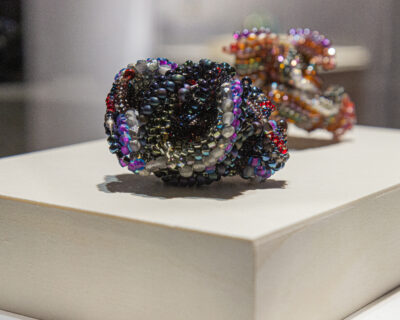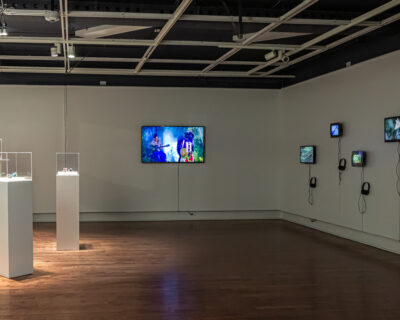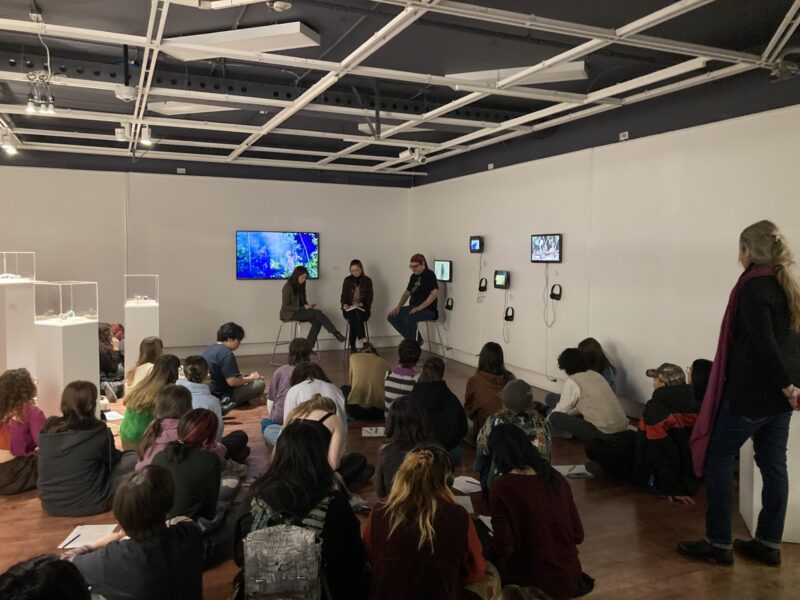Students interview multidisciplinary artist Craig Commanda
Craig Commanda is a multidisciplinary artist from the Algonquin nation at Kitigan Zibi. His current exhibition, WÌDJIDEYAMAWOWIN / INTERCONNECTION, features prints, videos, and complex sculptural beadwork at the Warren G. Flowers Art Gallery until March 16th. On a recent Friday afternoon, two visual arts students, Katya Kieran & Lisseth Llorente Ruiz, had the chance to ask Craig a few questions about his artistic practice and this exhibition.
K.K.: Where did you learn to do this type of complex beaded work?
C.C.: It was a bit of a journey to get to this point. My first experience with the medium was halfway through my cinema studies degree at Concordia, during the pandemic, when I found a #beadthisinyourstyle challenge on Instagram. I continued to practice, and soon participated in beadwork workshops run by a fellow indigenous artist named Nico Williams, who taught me techniques such as the flat peyote and flat peyote triangle. I used a variation of the peyote stitch – the Cellini – for the pieces in this exhibition, as the technique makes it possible to shape them into more complex forms. The practice of beadwork kept me sane during the pandemic, as I researched pieces that interested me and learnt how they were made. However, I still feel like I’m only at the tip of the iceberg of learning beadwork techniques.
K.K.: Is there any specific method that you use while creating the beaded pieces? Do you enter a particular mindset in terms of connecting to nature or culture?
C.C.: A lot of my works do have natural elements. For my artwork Undulation, I wanted to play with the shifting form of waves as well as establish the colour pattern of light refracted through water. Fall Leaf is curled up like a leaf in autumn, and Dark Heart looks like a small animal’s heart. In my video works, I start off with an idea or intent. However, I don’t always have a representation in mind when I begin doing art. I go with the flow in my beadwork, seeing where the art takes me, and whatever it becomes is what it needs to be in that moment.
K.K.: Is there a special importance behind using bones in your sculptures. What does it symbolize for you?
C.C.: Before colonization, many indigenous peoples used natural materials such as birch bark, bones, and porcupine quills as a way to not only trade but also to express themselves. Integrating these natural materials helps me connect more with my cultural heritage, and I aim to bring this cultural mindset into a contemporary setting.
K.K.: Could you describe how your experience, in terms of understanding and ownership over your own culture, inspired the artworks in this exhibition?
C.C.: The arts have been a really important part of my journey to grow closer to my culture, and learning traditional practices is a very important part of this for me. Last summer, I learnt the techniques of birch bark biting. In this exhibition they are shown in the form of photographic prints within display cases, but I do wish to go further with this practice in the future. Similarly, learning more about making leather from animal skin taught me about how important it has been for my culture both in survival and in terms of economic opportunity. These traditional practices inform my art, as I choose to work with natural elements, tying in the colour of the sky or the rocks or the sunlight into my beadwork as well as actual natural elements like northern pike bones.
L.L.R.: Can you explain the video making process to us? Did you film all the footage for the video works yourself? How and in what way did collaboration factor into these pieces?
C.C.: During a big part of my film career, I was working with a First Nations organization called Wapikoni Mobile. They help guide indigenous youth through training and practice with all aspects of film and music production: pre-production which is conceptualization, production with filming, and postproduction which is editing the material.
Working with film/video represented a form of therapy for me, it helped me through a serious period of depression, making the film The Weight, (2014) helped me gain clarity over what and where I was in life. I would not be here, being interviewed by you if I hadn’t made that film.
When it comes to the process of production, I take full charge of coming up with ideas and then work with the crew to get the production planning.
An exception to this process was the video Love Song, (with Marjan Verstappen, 2020) made with the Bawaadan collective, which is a collaboration. For Call and Response (2014), I did the conceptualization, wrote, and performed the soundtrack. I had help from the Wapikoni crew shooting it along with some youth from Kitigan Zibi.

Photo by Sylvia Trotter Ewens
L.L.R.: With regards to the video that focuses on music, how did you realize that there was something deeper to understand from the music rather than it just being used to enhance the video?
C.C.: Using music works as part of a storytelling device. It helps achieve a more unified result, rather than a refracted expression through the art pieces. I wanted to get closer to evoking a feeling or emotion through a multi-media exhibition, and by connecting the colors in the beaded Works with music and film. The guitar also helps me be able to express emotions that I’m trying to connect with in the moment.
L.L.R.: When you make art, how much of it is a personal desire to create and how much is the desire to share a message with the public?
C.C.: It is a mixture of both, but not at the same time. Most times, meaning comes later and the need to create comes first.
When it comes to film, I never start a video project unless I have something to say, since it takes a lot of work and care. I am not going to begin a video project if I don’t know where I’m going with it.
L.L.R.: You work with so many different media, what makes you choose one format over others?
C.C.: It depends on what I’m feeling at that moment. Personally, my curiosity drives me to experiment with mediums, and this process gives me ideas on how to express a message. For my first film, I wanted the audience to understand that they are not alone. It was a sign of solidarity towards mental issues and survivors, it was a therapeutic piece.
K.K.: Do you think that the constant state of changing and “shedding skin as a snake,” as mentioned in The Weight (video piece) ever stops in life?
C.C.: No, do believe this type of change is constant. Even simply from a physical standpoint, the cells in our body are replaced every 7 years. The more open we are to new experiences and changes, the more they help us shed our skin and leave behind outdated ways of thinking or believing, letting us learn about ourselves along the way and find new ways of expressing emotions. Personally, I learn about myself and my ancestors through films and beads. I come from a long line of people that lived in the bush, making canoes from scratch. Through this history and this knowledge, I want to introduce new ideas, and look at things in a new way. As I learn and create along those lines, I want my work to help contribute to other people also shedding their own skin.
L.L.R.: “We are everything and we are nothing” Could you explain a bit more about this duality and how you’ve seen it reflected in the process of becoming comfortable with your own existence and acknowledging your cultural roots?
C.C.: We are everything refers to the interconnection, considered by many First Nations, that we have with everything. We are a part of the natural world, there is a natural cycle, and once we die we give nutrients to the soil. At the same time, we are so small in the grand scheme of things that “we are nothing.” Life and the universe are so grand, and so our insignificance maybe also encourages us to strive for living our best lives.

Photo by Sylvia Trotter Ewens



